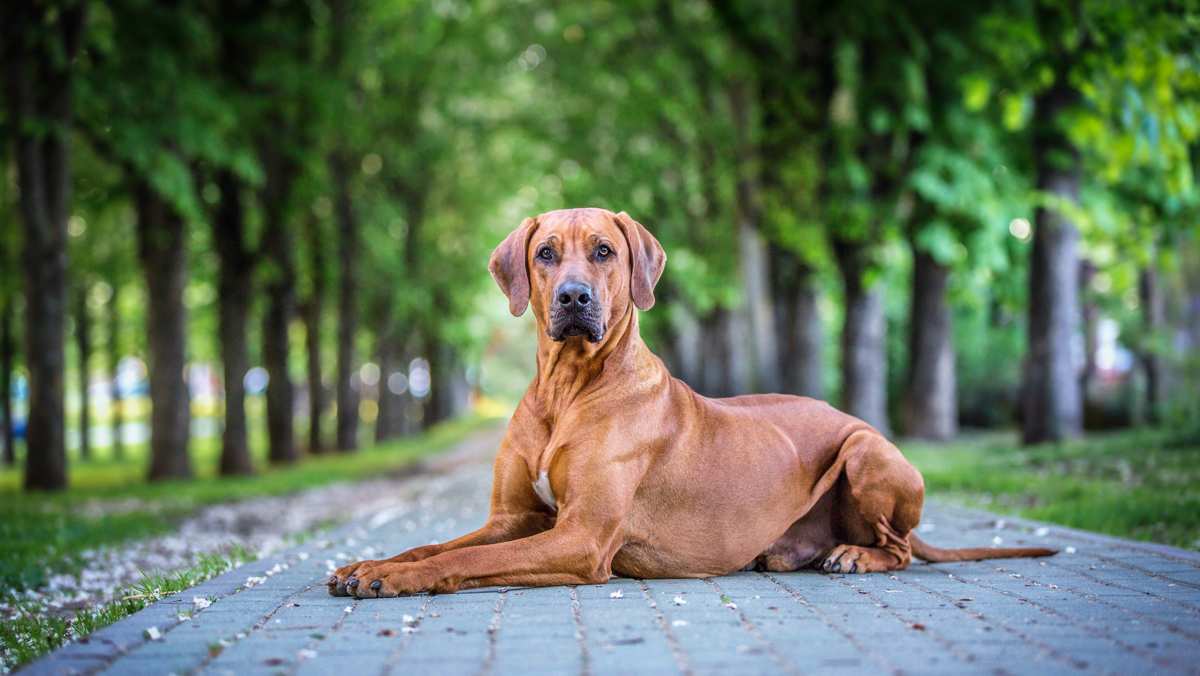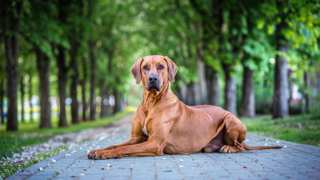Rhodesian Ridgeback Dog Breed
African Lion Dog
African Lion Hound
Artesian Ridgeback
Lion Dog
Ridgeback
The Rhodesian Ridgeback was originally bred in the South African region to guard farms and assist hunter in flushing out and bringing down game; they are widely known for their use in lion hunting in Rhodesia beginning in the late 1870s. The breed is dubbed "Ridgeback" because the hair along their spine grows in the opposite direction from the rest of the coat in a ridge-like appearance. While this is not a trait unique to the Rhodesian Ridgeback (there are a couple other "ridge" breeds), the breed is often considered an extremely beautiful and can often be spotted as mascots on many dog products.
Rhodesian Ridgebacks are an intelligent, sensitive, protective and affectionate...not to mention good-natured. Not convinced yet? They excel in nearly all athletic events and likely have the highest endurance of any dog breed making them a runner's dream dog as the breed can run a distance of 30 miles in 60-90 minutes. This low maintenance dog is easily trained and an excellent choice for families with children and other pets.
Rhodesian Ridgeback Breed Details
Rhodesian Ridgebacks are gentle, sensitive and even tempered companions that make excellent family companions if trained and socialized early. Although they may alert you to strangers and be aloof around guests, they are usually non aggressive and unlikely to attack unless trained as a guard dog. A large home with a fenced yard is best for this breed, however, they prefer to live indoors so the yard isn't mandatory if you can ensure them enough outdoor exercise daily. Although easily trained, this breed is best matched with an active, experienced owner that has plenty of time to include them as part of the household. Here are a few facts about the Rhodesian Ridgeback that you should consider before making your decision:
Great with kids
Great with other pets
Eye-catching looks
Low-maintenance grooming
Can live indoors or out
Easily trained (crate and obedience)
Great exercise companion
Protective and alert
Affectionate and loves to be near you
Quiet
Hardy, few health issues
Isn't happy being alone frequently
Can be very mischievous and destructive if bored, e.g. jumping fences
Curious little monkeys that will stead "people food" if they can reach it
Not suited for small apartments
Sensitive to cold and doesn't like water (including rainy weather)
Purebred
10 - 12 yrs.
24 - 27 in.
80 - 90 lbs
OverallFamily FriendlyChild FriendlyPet FriendlyStranger Friendly
Easy to GroomEnergy LevelExercise NeedsHealthShedding Amount
Barks / HowlsEasy to TrainGuard DogPlayfulnessWatch Dog
Apartment DogCan be AloneGood for Busy OwnersGood for New OwnersIntelligence
Rhodesian Ridgeback Breed Description
The Rhodesian ridgeback is a large sized dog breed which were bred to chase game animals to exhaustion and bay them until the hunters arrived. Ridgebacks commonly weigh in excess of 80 pounds, but should always look lean and athletic in appearance.
Rhodesian ridgebacks are a very intelligent dog breed making them an easy for obedience training. However, the breed can be strong willed at times so training should be done at an early age for best results. The breed has a high prey drive and will chase anything that runs away from it, because of this they may not make the best companion dog for cats although they do get along well with other dogs. The breed does extremely well with children and often sees kids as younger members of the family pack which need to be watched out for.
The ridgeback's coat requires little care to upkeep. They shed little, but will blow their coat twice a year. Brushing the coat weekly and bathing them when needed will keep their coat odor free and free of loose hair. The breed does require moderate exercise daily. Two short walks or one large walk per day is generally enough to satisfy the exercise requirements of ridgeback. However, the ridgeback has enormous stamina and can keep pace with marathon and long distance runners without tiring.
Rhodesian Ridgeback Breed History
The history of the Rhodesian Ridgeback is rather interesting. In addition to their "Lion Dog" reputation these skilled canines have also had many other purposes and jobs throughout history. For instance they are actually good bird hunting dogs as well as protectors of home and property.
In the mid 1600's when Dutch Settlers began trading in the region that is South Africa, they brought with them breeds such as Bloodhounds, Greyhounds, Mastiffs, Great Danes, Staghounds and various Terriers. They bred these dogs with the partially wild hunting dogs of the native Khoi Khoi and Hottentot peoples; these native dogs had the characteristic ridge running along the back. The farming descendants of the settlers (refereed to as Boers) would continue breeding what would become the Rhodesian Ridgeback out of necessity. They needed a dog that could guard the home as well as flush out and take down game from birds to large animals. Endurance and the ability to withstand temperature extremes, both sweltering and freezing, was a necessity-- and this breed amazingly achieved this! Not to mention their ability to travel 30 miles in less than 1.5 hours without excess water.
The new "Rhodesian Ridgeback" breed did not actually make its way into Rhodesia until Reverend Helm introduced a few there in 1877. Big game hunting was popular in this area and where men found thrill in lion hunting and the infallible Ridgebacks were key to the take-down of these creatures. By the 1920's there was such a wide acclaim for the skills and temperament of these dogs (not to mention the hallmark ridge) that a group of Rhodesian breeders got together to carefully craft a breed standard for the now Rhodesian Ridgeback. By 1950 these dogs had even reached the United States and the AKC swiftly recognized them by 1955.
Rhodesian Ridgeback Appearance
This breed isn't called the Lion Dog for nothing. Large, proud, sturdy and athletic, she appears capable of great endurance without being grossly muscled. This is to help her run swiftly for long distances (up to 30 miles in 60-90 minutes)! Of course, the most notable trait of this breed is the ridge of hair, up to two inches wide, that grows in the opposite direction that the rest of the coat; it begins after the shoulders in two small whorls and ends almost at hip level.
The Rhodesian Ridgeback's head is broad but of reasonable length; the ears closely frame the face and are medium in size overall, but broader at the base and ending at a point. Interestingly, eye color will vary from dark brown to amber based upon nose color; the more common black nosed individuals usually have dark brown eyes while the recessive, liver/brown nosed dogs often possess amber eyes. They have very straight, lightly muscled legs that end in small, compact paws with arched toes. The feet are one of the areas where a small amount of white coloring is allowed, however, the less the better for competitive purposes.
The short, low maintenance coat of the Ridgeback is most commonly some shade of Wheaten (either Wheaten, Red Wheaten or Light Wheaten). The coat is very functional for the hot weather the breed is accustomed to and the color allows them to blend in with grasses and brush.
Rhodesian Ridgeback Colors
The images below represent the coat colors and patterns associated with Rhodesian Ridgebacks.
Rhodesian Ridgeback Variations
Ridgebacks are big dogs and are not meant to come in "mini" varieties. Their natural size is a necessity and is perfectly suited for their initial purposes for farm work, hunting and protection. Miniature Rhodesian Ridgebacks may exist due to mutations that occur in every breed, we refer to them as "runts", however, purposefully breeding tiny Ridgebacks can cause the resulting puppies to have poor health. You should be skeptical of any breeder offer Mini Rhodesian Ridgebacks, Toy Lion Dogs, or any other fancy name they may create for a very small RR.
Rhodesian Ridgeback Temperament
The Rhodesian Ridgeback temperament is usually very stable and a well socialized one that has been through obedience training is an excellent family companion. They may look proud (and are) but they are also quite sensitive to harsh tones and treatment. This breed is extremely intelligent too and they will excel at obedience training, housebreaking, etc. very quickly. Praise, treats and consistency are the best motivators for these guys; training is VERY important because a bored, disobedient Ridgeback will be a big strong-willed, mischievous pain in the butt!
The personality of the Rhodesian Ridgeback makes him naturally protective of his family and he will often disregard strangers. If necessary, Ridgebacks will bark to alert you to the approach of a stranger or strange animal, however, this is usually of short duration because they aren't typically barkers otherwise. These affectionate dogs, known for their characteristic tolerance, do great with children and other pets providing they are well trained and socialized.
Contrary to his utilitarian looks he is not a dog suited to living in the yard or spending most of his time alone. Ideally, you will have a large yard but also plenty of indoor space to keep him. If he can he will spend all of his time with you, whether curled up on the couch or out in the garden. They do require daily outdoor time (preferably an hour or so) and enjoy hunting activities, running, hiking, trips to the dog park and just a good long walk. Many owners contend that their Ridgebacks do not like water.
This breed can live either indoors or out but prefers to be indoors with the owner. They abhor the rain and are sensitive to cold weather. A fenced yard is idea but not necessary and, while they aren't recommended for small living spaces like apartments, will do just fine in an average sized home. Note that a fully grown RR can jump your outdoor fence if left bored and under stimulated. Inside the home, they may even seem calm and lazy but watch out, they are known to be very mischievous (especially when bored) and you may find that your snack has disappeared off the table as soon as your back turned.
Ridgebacks are natural protectors of the home and will bark to alert you of a strangers approach-- otherwise they are quiet dogs. When in the proximity of guests, expect them to be aloof but not aggressive.
Note that Rhodesian Ridgebacks are not hypoallergenic and are not a top choice for those with allergies. Although no dog is truly "hypoallergenic" some produce less allergy inducing dander than others, however, this is not one of them. They don't have an undercoat and although their short coats do shed, brushing a few times per week can lessen this; bathing should only be done as necessary.
Rhodesian Ridgeback Health
Whereas many purebreds have long lists of potential health conditions that stretch on and on, the Rhodesian Ridgeback is quite sturdy. A natural, high quality diet and plenty of exercise should allow them to live their full, healthy lifespan of 10-13 years. They are almost always found in great shape, however, a brief list of conditions to watch out for is as follows:
- Hip Dysplasia
- Thyroiditis- Hypothyroidism, in particular is increasingly common and manifests as weight gain and hair loss; it is detected via blood test.
- Eye Disease
- Bloat
- Dermoid Sinus- Rare infiltration of the neural tube by dirt, debris and infectious material that travels to the spinal cord and causes great damage such as meningitis. Costly to surgically remove and may be deadly.
- Canine Papillomas- Caused by a contagious virus (only to dogs), these warts in your dogs mouth should disappear over time.
- Degenerative Myelopathy- This rare spinal condition causes partial paralysis of the limbs over time
Rhodesian Ridgeback Health Concerns
Below are potential health concerns associated with Rhodesian Ridgebacks.
Hip dysplasia
Elbow dysplasia
Dermoid sinus




